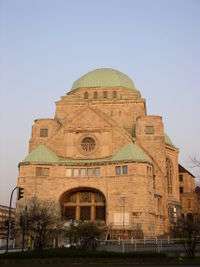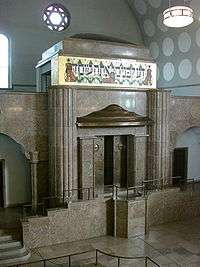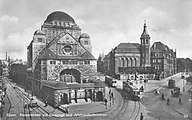Old Synagogue (Essen)
The Old Synagogue (German: Alte Synagoge) in Essen is one of the largest, best preserved and architecturally most impressive testimonies to Jewish culture in pre-war Germany. Built in the centre of the city, the Byzantine style former Synagogue was originally consecrated as the Neue Synagoge in 1913, and is now an institution dedicated to documenting and promoting the history of former Jewish community of the city.

After being severely damaged in Kristallnacht in 1938 but avoiding further bomb damage, the burnt out interior was completely redesigned to become a Museum of Industrial design in 1960, and then restored to something like its original appearance in the 1980s when it began its new role as a memorial centre and museum. The attached Rabbinerhaus (House of the Rabbi) has housed the Salomon Ludwig Steinheim Institute since 2011.
History of the building

With a rising number of Jewish families moving to Essen in the early 19th century, a community was formally established in 1858.[1] The reform-oriented Rabbi Salomon Samuel was appointed in 1894, and with the growth of the community Jewish community, he decided to build a new large synagogue in the middle of the city center, to mark the importance of Judaism in German society. The architect Edmund Körner was appointed, and designed a large Byzantine style stone building topped by a copper done, with an interior was tiled deep blue with gold highlights, influenced by Jugendstil. Salomon Samuel provided guidance regarding the interior decoration to reflect Jewish traditions, especially the symbols to be used for the mosaics and stained glass. It was one of the largest in Germany, 230 feet (70m) from front to back, 98 feet wide, and the dome reached a height of 112 feet (37m).[2] The building was inaugurated as the New Synagogue on September 25, 1913, and for 25 years it was the cultural and social center of a community with around 4,500 members in 1933. The main hall (which was also often used for concerts) could hold more than 1500 people with several galleries, organ and a large bima area. The building also housed space for a weekday synagogue, classrooms, a community hall, a secretariat, a library, and a garden, with apartments for the rabbi and the cantor in an attached Rabbinerhaus behind.
The seizure of power by the National Socialists in 1933 was followed increasingly anti-Jewish policies, and on 9–10 November 1938, a night known as Kristallnacht, Jewish owned business and especially synagogues were attacked and many burned to the ground. The Old Synagogue was also set alight, and the fire devastated the interior but the exterior remained nearly intact.[3][4] Although Essen itself was very heavily bombed (see Bombing of Essen in World War II), the building itself managed to survive the Second World War without further damage.
From 1945-1959 the former synagogue stood unused as ruin at the edge of the Essen city center. In 1959, the surviving Jewish community, after it had been using Rabbinerhaus as their center, built a new, much smaller synagogue, which is the current place of worship. In the same year, the city of Essen acquired the former synagogue and in the following years of 1960/1961 renovated it into a museum for industrial design, the "Haus Industrieform". For this purpose the interior was renovated redesigned to a much more sober form to fit the purpose, the remnants of ark for the torah were removed and any surviving mosaics and ornaments were plastered or painted over. The main prayer hall was divided by a new floor and the ceiling was covered up.
A fire, caused by a short-circuit, severely damaged the Design exhibition in 1979. This event and a changed attitude toward handling historic buildings finally caused the city council of Essen to found the current institution Alte Synagoge, a place of remembrance and a centre for historical and political documentation.[5] From 1986-1988 the entire building was reconstructed, funded by the state of North Rhine-Westphalia, recapturing something of the former appearance, restoring the soaring dome (in plain plaster rather than the original blue mosaic), reinstating the balcony and reconstructing the marble torah.
Today
In 2008, the City Council of Essen decided to develop the Old Synagogue into a house of Jewish culture as well as a memorial. For this purpose, interior renovation measures were carried out in order to create new exhibition areas. Steeler Str on the south side of the building was redirected allowing the creation of a paved area named Edmund-Körner-Platz, after the architect of the Synagogue. The official reopening took place on July 13, 2010. Today the Alte Synagoge offers exhibitions and events for those interested in Jewish culture and religion, past and present. Cultural events such as concerts, plays, and readings are also offered.[6]
The Salomon Ludwig Steinheim Institute, established by the state of North Rhine-Westphalia since 1988, researches the cultural, religious, and literary history of the Jews in the German-speaking world. Since May 2011 it has been located in the Rabbinerhaus in Essen, and cooperates in research and teaching with the University of Düsseldorf.[7]
Gallery
 The Old Synagogue from outside
The Old Synagogue from outside.jpg) The Old Synagogue from inside
The Old Synagogue from inside The Old Synagogue in 1922, on the right is the Friedenskirche (Church of Peace)
The Old Synagogue in 1922, on the right is the Friedenskirche (Church of Peace)
References
- "Old Synagogue Essen". Information Portal to European Sites of Remembrance.
- Archivist (2018-11-06). "Essen's Alte Synagoge that Survived Kristallnacht". JHSD. Retrieved 2020-02-03.
- "Synagogue Destroyed during Kristallnacht". Facing History and Ourselves. Retrieved 2020-02-03.
- "Pictures from the interior". www.essen.de. Retrieved 2020-02-03.
- "History of the House". www.essen.de. Retrieved 2020-02-03.
- "Welcome to the "Old Synagogue" Essen". www.essen.de. Retrieved 2020-02-03.
- "Institut - Salomon Ludwig Steinheim-Institut für deutsch-jüdische Geschichte an der Universität Duisburg-Essen". www.steinheim-institut.de. Retrieved 2020-02-03.
External links
| Wikimedia Commons has media related to Alte Synagoge (Essen). |
- Alte Synagoge Essen website—(in German)